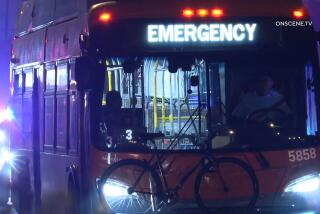No One Wins When It’s Bus Vs. Rail
- Share via
Over the past several years, the Bus Riders Union and others have worked hard to improve the MTA’s bus services. Unfortunately, to bolster their case, bus advocates have felt compelled to disparage the rail component of our transit system, the demise of which they see as the only solution to their bus problem. Many of their contentions, however, are simply wrong. Let’s look at five of them:
* Rail riders account for only 9% of total transit riders and therefore the rail program has been a waste. By comparison, only 10% to 20% of all auto trips use freeways. Yet no one is calling the freeway system a failure. What makes the freeway system so important is that it carries 52% of all vehicle miles traveled within the county. So, too, rail carries a lot of transit users many, many miles--22% of the MTA’s total passenger miles of travel. In a sense, the fledgling rail system is already half as important to the transit system as freeways are to our road system.
* The rail system has been built for suburban whites at the expense of the urban minorities. Minority riders make up 89% of the riders on the Blue Line, 86% on the Green Line and 75% on the Red Line. MTA bus ridership is 88% minority. This is hardly a difference worth arguing over. Metrolink is the only rail system that actually reaches the so-called “white” suburbs; its ridership is 40% minority, generally reflecting its corridor demographics.
* The rail services are poorly used and do not justify their investment. Each day, more than 142,000 people travel by train in Los Angeles County to get to work, school or pleasure. The Blue Line, with a ridership of 54,000 trips per day (crush-loaded throughout the peak periods) has more riders than any other single light rail line in the United States. The Red Line, until Saturday, barely reaching beyond downtown Los Angeles, already carries 38,000 daily riders. The Green Line, with 25,000 daily riders, has had ridership comparable to the much-praised Portland and St. Louis light rail systems. And Metrolink trains add in another 27,000 daily rail trips. By comparison, 52 of the MTA’s 125 bus lines carry fewer than one-tenth the Green Line’s daily ridership, and it would take the combined ridership of MTA’s 65 lowest ridership bus lines to equal the ridership on its three rail lines.
* The rail system is unfairly using most of the MTA’s transit capital dollars. The MTA does spend more capital dollars on the growing rail system, but the complaint avoids the real question: Does MTA have a choice? Proposition A, passed by the county’s voters in 1980, requires 35% of the revenues collected be used for rail construction. Proposition C, passed in 1990, requires 25% of its revenues be used for rail construction. A portion of another 5% is earmarked for Metrolink. Much of the rest is used for buses either by the MTA or local bus operators. While the bus advocates would like the MTA to ignore the voter-approved formulas, the MTA cannot, which is part of the dilemma it now faces in buying more buses.
* Rail passengers are more subsidized than bus riders. The MTA each year budgets approximately $100 million for rail operations and $650 million for bus operations. The subsidy per passenger boarding is higher on rail, but rail trips are longer than bus trips on average. Excluding the Red Line, subsidies for rail passengers are equal to or less than for bus passengers calculated by miles traveled. A bus passenger actually receives twice as much subsidization than a Metrolink rider on a mile-for-mile basis.
All this is not intended to say rail is better than bus. The bus and rail systems both serve different but needed roles: Rail serves longer distance, higher speed trips while the bus system provides local access. To say we should have one without the other is like saying we should have surface streets but not freeways. Behind the needless smoke screen of the bus-versus-rail battle, the Los Angeles rail system is already having more of an impact than we give it credit for.
More to Read
Sign up for Essential California
The most important California stories and recommendations in your inbox every morning.
You may occasionally receive promotional content from the Los Angeles Times.










